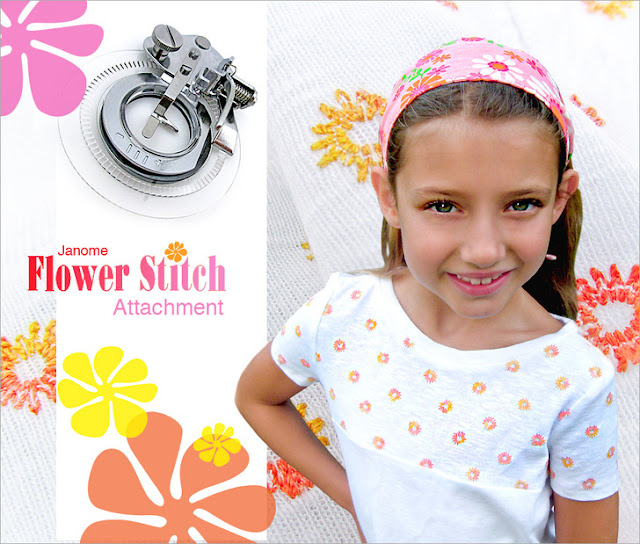The Janome Flower Stitch Attachment is the flower girl of the sewing accessory world, allowing you to sprinkle pretty posies over any project. The attachment fits Janome low shank sewing machines with a maximum stitch width of 7mm. It is not compatible with machines that include embroidery, have the Janome AcuFeed™ or AcuFeed Flex™ systems, or feature a maximum 9mm stitch width. For more basic sewing machines, it's a fun and easy way to add little decorative stitch touches in pretty thread colors!
The attachment adjusts to give you small, medium, and large options for each recommended stitch pattern. You can even combine patterns to create your own unique designs made up of concentric circles. It can also be used to create eyelets.
It's a lovely effect to add a scattering of color and texture across a garmet or home décor project. Try a variegated thread to increase the impact.


Setting up the machine
- Turn the power switch off.
- Raise the needle and presser foot, then remove the foot holder and standard presser foot.
- Thread the needle and bobbin.
- Place the Flower Stitch Attachment in position. Make sure the Raising Lever sits above the needle clamp.

- Use a screwdriver to tighten both the thumb screw and the needle set screw to prevent them from loosening while the attachment is working.
- Drop the feed dogs.
- Reduce presser foot pressure to 3 and set the thread tension to 1 - 3.
- Select a stitch from the list below.

- Adjust the stitch width to no more than 5mm. As shown below, you should try some test samples to review all the options you can achieve by varying the stitch itself as well as the stitch width.
- Loosen the back screw on the attachment (the screw that sits horizontally) to move the disc right and left between the –and + marks embossed on the disc itself. This movement left and right determines the size of the flower. When set to your chosen position, re-tighten the screw.

Start stitching
- As with most decorative stitching, a stabilizer is recommended behind your project to keep both the fabric and the stitches smooth. With the Flower Stitch Attachment, because it is actually turning the fabric, an iron-on stabilizer is recommended for fewer issues with shifting.
- Place a dot on your fabric where you wish a flower to be stitched. The flowers stitch in a circle from this starting point, which means the dot is the outer ring of the stitch pattern not the inside of the circle. Keep this in mind if you are precisely centering your flowers rather than randomly sprinkling them.
- Place your fabric under the attachment, position the area to be stitched within the center of the disc.
- Lower the presser foot and turn on the power.

- DO NOT back stitch or use a locking stitch, This is important because the Flower Stitch Attachment moves forward with every needle penetration; you risk damaging the attachment, breaking needles, or marring the needle plate if you attempt a locking stitch or back stitch.
- Instead, hold the needle thread lightly with one hand, then raise and lower the needle to pick up the bobbin thread. Sew just a couple stitches to lock the threads. Then, cut away the excess threads. This is similar to how you might start a machine embroidery design.

- Continue sewing at a slow to medium speed to create a flower. This flower was created with a Tricot (3-step zig zag) stitch.
- Changing the lever at the front of the disc from the - at the left to the + at the right changes the shape and size of flower.
- The lever in left position is the the small flower.

- The lever in center position is the medium flower.
- The lever in right position is the large flower.

- When you finish sewing, remember you do NOT lock or back stitch. Instead, simply raise the needle to its highest position and raise the presser foot. Cut the threads, leaving long tails.
- When done with all your flowers, pull each bobbin thread to bring the needle thread through to the wrong side of the fabric, then knot the two thread tails together to secure.
Create a stitch sampler
- To familiarize yourself with the Flower Stitch Attachment and try out all the options, we suggest creating small stitch samples.
- Cut 6” squares of a plain cotton and fuse stabilizer to the wrong side.
- Use a permanent marker to place three dots as your starting points.
- Make a sample of each suggested stitch, changing the position of the disc for each dot. Then write down the stitch number and settings used for future reference.





























No comments:
Post a Comment